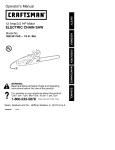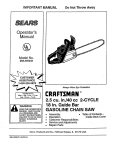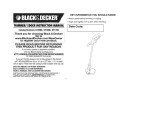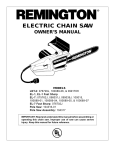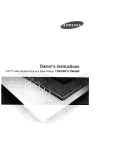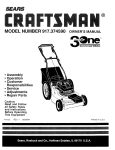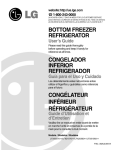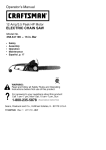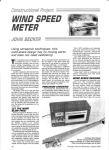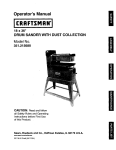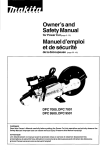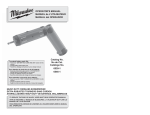Download Remington 100089-06 Owner`s manual
Transcript
REMIN N 8' ELECTRIC=TElESCOPING INTRODUCTION Your Remington Telesooping Pole Saw is a dual purpose product. The electric chain saw is a separate operating unit when not assembled to the telescoping pole. Before operating either the chain saw or the Pole Saw, make certain you read and understand all Safety Warnings. 8. A SAFETY WARNINGS Make Certain you read and understand all Safety Warnings on pages 2 and 3. Improper use of this Pole Saw can cause severe injury or death from fire, electrical shock, body contactwRh moving chain, or falling wood. 9. BEFORE OPERATING SAW 1. Read and understand both chain saw and Pole Saw manuals before operating saws. 2. Watch what you are doing. Usa common sense. Do not operate saw when you aretired. 3. Use chain saw for cutting wood only. Do not use chain saw for purpose not intended. Do not use for cutting nonwood items. 4. Use only electrical voltage noted on model plate of chain saw.. 6. Use only extension cords marked for outdoor use. See Operating Chain Saw section of chain saw manual for extension cord requirements, 7. Do not operate Polo Saw or chain saw • while under the influence of alcohol, medication, or drugs • in rain or in damp or wet areas • where highly flammable liquids or • if tfiggex does not turn saw on and off. Chain must stop moving when you release trigger. Haye faulty switch replaced by authorizedservice center.See chain saw manual for listing of authorized service centers. • whiin in a hurry • wl_e in tree or on a ladder • while on aerial booms, buckets or pisiforms Wear sung-fittlng clothes when operating Pole Saw or chain saw. Do_not wear loose clothing or jewelry. They can get caught in moving saw chain. Be aware ofexteusion cord while oporating chain saw. Be cerefiq not to trip over €ord. Keep cord awa'. _m chain and operator at all times. - 4. Keep children, animals, and bystanders away from Pole Saw and extension cord.OnlyPoleSaw usershould hein work area. 5. Do not use the Pole Saw to cut down trees. Use the chain saw without pole attachment and only if you are trained or have expert help. 6. Do not use near power lines. Keep at least I0 feet away from electricallines. 7. GripPoleSaw securely -onehandon thepole, theother on thehandle. 8. Keep finger off_gges undlreadyto make cut. 9. Beforestarting PoleSaw, make sure chainis nottounldng anything. Wear the following safety gear when operating saws: • heavy-duty gloves (wear rubber gloves when working outdoors) • steel-toed safety footweur with nonskid soles • eye protection such as safety glasses, goggles, or face screen • safetybardhat , • ear mufflers or ear plugs areas) 10. Before cutting, always provide the following: • clearwork area • secure footing • planned retreat path from falling limbs gasesarapresent • if pule or saw is damaged, edjusted wrong, or not fully and securely ..... assembled • II. Inspect tree hefore trimming. Make allowance for branches to fall freely to the ground. 12. Do not Use your Polo Saw to fell saplings. Use the chain saw without pole attachemenL .::7"i _ 13. To reduce the risk of electric shock, this saw has a polarized plug (one blade is wider than the other). This plug will fit in a polarized oudet only one way. If the ping does not fit fully in the oudet of your extension cord, reverse the plug. If it still does not fit, a polarized extension cord will be necessary. Do not change the plug in any way. WHILE OPERATING POLE SAW ....... 1. Ot_y ,.... tutti* -_- .......... _;UI_dLUUU Ub_ _cnse SAW 3. • hair coveting to contain long hair • faceor dust mask (ifwortdng in dasty Only well-iusmtcted adults should operate Pole Saw or chain saw. Nero allow children to operate saws. 5. POLE willie -_pe._dn_ _uni-L ............ "="-" _` 2. Keepwork areaclean. Cluttered areas invite injuries. 10. To guardagainst elec=ical shock, avoid body contact withgroundedobjects suchaspipes, fences, andmetalposm. 11. Keepall parrs ofbodyawayfromchain when saw isrunning. 12. Do not force chain saw while cutting. Apply light pressure.It will do the job better and safer at the rate for which it was intended. limbortree trunkthat is 13. When cutting under tension, use extreme caution. Be alert for wood springing back. When wood tension isreleased, limbcould spring backand strike operator causingsevere injury ordeath. 14. CarryPoleSaw fromoneplacetoanother • withunit unplugged • with telescoping pole returned to shortest position • by holding pole at balance point (close to saw end) • with guide bar and chain to rear Do notcutsmallbrushand saplings 15. with the Pole Saw. Use the chainsaw only, with extreme care. Slender matter may catch in the chain and be whippedtoward you.Thiscouldalso pull youoff balance. OWNER'S SAFETY WARNINGS • Use low-kickback chainand guidebar supplied with thechain saw, Only use replacementpartsListedf_ the polesaw. continued • Never u_ dni] c_loo_ chain.Kecp chain sharp and adjusted correctly. KICKBACK _WARNING: Kickback may occur when the nose or tip of the guide bar touches an object, or when the wood closes In and pinches the saw chain in the cut. Tip contact in some cases may cause a lightning fast reverse reaction, Idcldng the guide bar up and back towards the operator, Pinching the saw chain along thetop of the guide bar may push the guide bar rapidly back towards the operator. Either of these reactions may cause you to lose control of the saw which could result in serious Injury to user. Kickback Safety Devices On This Saw This saw has a low-kickback chain and reducedkickbackguidebar.Both items reduce the chance of kickback, however, kickback can still occur with this saw. The following steps will reduce the risk of kickback.. MANUAL Saw Maintenance and Kickback Safety Followmaintenanceinstxuctious in thechain saw manual.Propercleaning of saw and chainandguidebarmaintenance canreduce chancesofkickback. Inspect andmaintain saw after each use. This will increase the service life of your saw, Note: Even with propersharpening, riskof kickbackcan increase with each sha_aning.. MAINTENANCE AND STORAGE POLE SAW OF Never stand on a ladder or other type of unstable support while using the Pole Saw. Always use both hand_ to operate Pole Saw. Keep a firm, steady pressure on the Pole Saw while cutting but do nottry to force the sawthrough the wood. Do not use the Pole Saw to cut limbs larger in diameter than the length of the guide bar. UnplugPoleSaw from power sourceand followmaintananc¢ andstorage procedures outlined in the Maintenance and Storage section of yoor chain saw manual. POLE SAW TRIMMING PRECAUTIONS Keep other persons away from cutting end of polesaw and at a safe distance from work area. • Use both hands- one gripping the han_e and the otherg_pping thepole. Use firm grip. Thumbs and fingers must wrap around pole and handle. • _ep,..a]l safeP] items in place on saw. Make sum they work properly. • Do not overreach or extend arms above shoulder height. • Keep solid footing and balance at all times. • Never try cu_ing throughtwo branches at the sametime. Only cutone at a time. • Do not burygnide bar neseor Izyplunge cut (boring into wood using guide bar nose). • Watch for sldt'ting of wood or other forces that may pinch chain. Never stand directly under the limb you are trimming. Always position yourself out of the path of falling debris. Do not use Pole Saw near cable, elec- • Use ex_¢me caution when re-entering a previous Io_ tric power or telephone lines. Maintaln a mlni_num ciea-rance-of 10 f_t from all power lines. 3 REMIN N 8' ELECTRIC TELESCOPING POLE SAW PRODUCT IDENTIFICATION HandGuard Saw Chain \ Guide Bar Power Cor_ Gr_ Area Coupling_. Nut Handle Bracket Inner Pole Outer Pole Tdgger Switch Lock-out _Power Cord Figure 1 -Pole Saw Product Identification POLE SAW NAMES AND TERMS Coupling Nut Thieaded collar (loosento slide inner pole, dghtea to hold pole in position). Guide Bar Metal bar that extends from saw body. The guide bar supports and guide* chain. Inner Pole The moveable section of robing m which the saw is attached. Kickback Quick backward and upward motion of guide bar. Kickback may occur when tip of guide bar touches an object wkile chain is moving. The guide bar will kick up and back towards operator. Oiler Control System for oiling guidebar and chain. Trigger Device that turns saw on and off. Squeezing trigger turns saw on. Outer Pole Retains the moveable inner pole. Releasing trigger turns saw off. Saw Chain (Chain) Loop ofchef.ring cutting teeth for cutting wood. The motor ddve.sChain.The guidebar supports chain. Sprocket Toothed wheel that drives chain. Switch Device thatcompletes orinterrupts electrical circuit to motor of saw. Switch Lockout Devine that reduces accidentalstartingof saw. Trimming (Pruning) Processof cutting limb(s) from a living tree. Undercut An upward cut fzom underside of log or limb. This is done while in normal cutting position and cutting with top of guide bar. OWNER'S SAW CHAIN TENSION ADJUSTMENT UNPACKING 1. Remove allitems from carton. 2. Chock allitems for any aldpp'mg damage, If you find any damage or ff any parts are missing, promptly inform deelar where you bought the Pole Saw. WARNING: Maintaln proper chain tension. A loose chain will increase the risk of kick back. A loose chain may jump out of guide bar groove. This may injure operator and damage chain. A loose chain will cause chain, guide bar and sprocket to wear rapidly. ASSEMBLY The plastic hardware bag for the Pole Saw should include the following: CHAIN SAW HARDWARE • • • • • • (2) (2) (1) (1) (I) (1) (1) 1. Guidebar bolts Guidebar outs Phillips sdftapping screw Saw chain Guide bar Hand g_rd Scabbard POLE SAW HARDWARE 2. Turn adjusting screw cIockwlsu until all slack is out of chain. Note: Them should be no gap between side links of chain and bottom of guide bar. 3. Wearing protectivegloves,move chain around guide bar. Chain should move freely. If chain does not move freely, loosen chain by turningadjusting screw counterclockwise, . After chain tension is correct, tighten guide bar nuts firmly. If not, guide bar will move and loosen chain tension. This will increase the risk of kickback. This can also damage saw. • (1) Handle bracket • (4) #I0 x 24 Phlnlpsscrews • (4) #101ockwashers ASSEMBLY OF CHAIN SAW Asserable the chain saw before assembling the pole. Refer to chain saw manual for assembly iustructions. To adjust chain tension, make sure guide bar nuts are only finger fight. Also make sure adjusting block is in oval adjust_g hole on guide bar. on saw backwards. If chain is backwards, ,_ CAUTION:saw Dowill notvibrate place badly chain and will not cut. MANUA ASSEMBLY OF POLE SAW _'/: • l. Slip handle bracket over chain saw handle from the fight side (see Hga_ 5). Note: The trigger must be depressed before the bracket will go onto the handle, • Push the lockout buttonanddepress tbe trigger, While holding the trigger in, place the trigger support portion of the bracket under the trigger and slide the bracket onto the chain saw handle.The bracket will keep the triggerin the "on" posifiou, 2_ Align holes in pole bracket with holes in handle bracket. Install Phillips head screws with lcokwasb_ through pole bracketfromleft side and threadinto theweld nutson thehandlebracket. Tightenscrewssecurely by hand. 3. Plugthesawpowercordinto receptacle cordatendofinner pole. Bracket Trigger Support Figure 5 - Bracket with Trigger Support F Make sure cutting edges of chain are facing in the right direction. Position chain so cutflog edges on top of guide barface grade bar nose (see Figure 2). Towards Cutting Guide Bar. ",Edge Nose Figure 3 - Turning Adjusting Screw Figure 6- Assembly ofPole SawBrackef Edge Chain F?gum 2- Chain Position incorrectTension Figure 4 - Saw Chain Adjustment to,_ 5 REMIN N! 8' ELECTRIC OPERATING SAW TELESCOPING PoLE WARNING: Read end understand this owner's manual before operating this Pole saw. Make certain you read and understand all Safety Warnings. Improper use of this Pole Saw can cause severe in)ury or death from fh'e, electrical shock, or body contact with moving cha|n, or falling wood. EXTENSION CORDS ADJUSTING POLE LENGTH POLE SAW CUTTING WiTH THE POLE SAW The RemingtonPoleSaw hasa tele,_oping I. pole assemblythatwin extend _ 57 inches(fully retracted) to 96 inches(fully extended). A threaded compressioncou- 2. plingis used to hold the pole in position at any extended length. 1. To extend thepole, loosencoupling by turning coupling nut €ountemlockwise asshown inFigure8.Polewillslide 3. freely. 2. Pullinnerpolesection outto desired length ofexteusinn. Note: Only extend 4. pole to minimum length required to reachlimbthat isbeingcut. Connectsaw to extension cord_Connect extension cord to power supply. Use beth hands to grip Pole Saw. Use only designated grip areaswhen oper_ atingPole Saw (see Fignre 9). Use firm grip. Thumbs and fingers must wrap around Pole Saw handle and pole. Make s_e your footing is firm. Keep feet apart. Divide your weight evenly on both feet. Whea reedytomake acat, press intriggerswitchlock-out andsqueeze_gger switch(seeFigure10). Thiswill turnPoleSaw on.Releasing u-igger switchwillturnPoleSaw off. Make suresaw isrunningatfull speedbeforestarling acot. 3. To lockpoleinposition, tighten coupling byturning coupling nu_clockwise (see Figure 8) un_ _mIy hand tight. Maim sure saw handle is alignedwith pole handle before tightening coupling 5. When starting a cut,placemoving nut. IMPOFfFANT:Do not use wrench chainagainst wood. Hold PoleSaw Use propersizecordwiththissaw.Cord or pliers to ove_ghtea coupling. Damfirmly inplace toavoid possible bouncmust be heavy enough to carrycurrent age to coupling or pole may result. ingorskating (sideways mo,iameat) of needed. An undersized cordwillcausevoltsaw. age dropatsaw.Saw willlosepower and . GuidePoleSaw usinglight pressure. overheat. Follow cord size requ£rements Do notforce PoleSaw.Themotorwill listed below. overload andcanbum out.Itwilldo Cord Length AWG cord size thejobbetter andsafer attheratefor UNLOCK LOCK 25 feet 16 whichitwasintended. 50 feet 16 Figure 8 - Extending Telescopic Pole . Remove Pole Saw froma cut with saw 1oofeet 14 running atfull speed. Stop Pole Saw 150 feet 12 by releasing trigger. Make surechain OILING CHAIN hasstopped before setting PoleSaw Keep cordaway from cuUingarea.Make down. To oil chain, press o il cap. O il will f eed onto surecorddoesnotcatchon branches orlogs Pressoilcap at least duringcutting. Inspect cordsofinu. Replace guidebarandchain. oncebefore each cut. A lwayscheckoil level damaged cords.The extension cordmay usingPoleSaw.Checkoillevei often come undonefrom thepower cordduring before by looking atoilsight level hole. Oilsight use.To avoidthis, make aknotwiththetwo level hole is on left side of saw, between cords as shown in Pigum ?. front handle and front hand guard. Do not attempt to operate the oiler while cutting Extension Chain Saw with the Pole Saw. Use properextension cordswiththisPole Saw. Use onlyextension cordsmarkedfor outdooruse.The cordmustbe markedwith suffix W or W-A following thecordtype designation. Example:SJTW-A orsyrw. Figure 9 - Designated Gdp Areas TriggerSwRch_" Figure 7- TyingExtension Cordand Power Cord In Knot Figure lo.Pole sa,,,en ie Switch Lock-out OWNER'S OPERATING SAW POLE 2rid Cut. Continued TRIMMING i I A TREE Pmn.ingCut PRUNING) WARNING: Avoid kickback. Kickback can result in severe injury or death. See Kickback, page 3, to avoid risk of kickback. I I( -._ _ WARNING: D_) not operate Pole Saw while in a tree, on a ladder or any other unstable work surface, or in any awkward position. You may lose control of Pole Saw causing severe injury. *(_ WARNING: Do not extend arms above shoulders when using Pole Saw. 2.io,. 1st Cut PruningUndercut (to avoidsplintedng) 3rd Cut - Stub Undercut (toavoidsplintering) Figure 11 - Cutting A Limb CAUTION: Seek professional help if facing conditions beyond your ability. Tdmmlng a treeistheprocc,ss of cutting limbsfrom aliving t_e.Make surefooting is firm. Keep feet aparL Divide your weight evenly on both feet. 1. Make first cut six inches f_om tree trdnk on underside of limb. Use top of guide bar to make this cut. (Cut I/3 through diameter of limb, see figure I l). 2. Move two to four inches farther out on limb. Make second cut from above limb. Continue cut until you cut limb off. 3. 4. Make third cut as close to tree trunk as possible on underside of limb stub. Use top of guide bar to make this cut. Cut 1/3 through diameter of stub. Make fourth cut directly above third cut. Cut down to meet third cut. This will remove limb stub. _ 7 MANUAL CONTENTS SECTION PAGE Safety Warnings ............................................................................ 2 Before Operating Chain Saw .................................................. Kickback ................................................................................. Pushback and Pull-in .....; ......................................................... 2 3 4 Chain Saw Operation ............. :................................................ Maintenance and Storage of Chain Saw ................................ Product Identification .... .................................... :........................... Chain Saw Names and Terms ....... ................................................. 5 5 6 7 Unpacking ...................................................... ................................ Assembly ....................................................................................... Saw Chain Tension Adjustment .................................................... 8 8 l0 Filling Oil Tank ............................................................................. Operating Chain Saw ..................................................................... l1 12 Extension Cords ............................................................ Oiling Chain ........................................................................... [ I :......... 12 12 Cutting With the Chain Saw ................................................... Trimming a Tree ..................................................................... Felling a Tree ............................... :.......................................... Limbing a Tree ........................................................................ Bucking a Log ......................................................................... Cleaning and Maintenance ............................................................ Cleaning Saw Body ................................................................. Care of Guide Bar ................................................................... 13 14 15 17 18 20 20 20 Sharpening Your Saw Chain (Non-Fast Sharp Model) .......... 21 Sharpening Your Saw Chain (Fast Sharp Model) ................... 24 Storage.................................................................... 25 Troubleshooting .................................................. :.......................... 26 TechnicalService................... _.................................................. 27. ServicePublications .......................................................... 27 RepairService.............................................................. 27 ReplacementPartsand Accessories.............................................. 28 PartCentrals................................................................ 29 AuthorizedServiceCente_ ........................ _.................................. 29 WarrantyInformation......................................................... Back €,.;ove, r \ SAFETY WARNINGS Make certain you read and understand all Safety Warnings on pages 2 through 5. Improper use of this chain saw can cause severe injury or death from fire, electrical shock, body contact with moving chain, or falling wood. m_ BEFORE OPERATING CHAIN SAW I. Read and understand this owner's manual before operating chain saw. 2. Use chain saw for cutting wood only. Do not use for cutting any non-wood items. 3. 4. 5. 6. Only well-instructed adults should operate chain saw. Never allow children to operate chain saw. Use only electrical voltage noted on model plate of chain saw. Use only extension cords marked for outdoor use. See page 12 for extension cord requirements. Do not operate chain saw. • while under the influence of alcohol, medication, or drags • in rain or in damp or wet areas • where highly flammable liquids or gases are present • if saw is damaged, adjusted wrong, or not fully assembled • if trigger does not turn saw on and off. Chain must stop moving when you release trigger. Have faulty switch replaced by authorized service center. See page 29 for your nearest authorized service center. • while tired or in a hurry • while in treeior on a ladder unless trained to do so _7017 A SAFETY WARNINGS Make certain you read and understand all Safety Warnings on pages 2 through 5. Improper use of this chain saw can cause severe injury or death from fire, electrical shock, body contact with moving chain, or failing wood. 7. Wear snug-fitting clothes when operating chain saw. Do not wear loose clothing orjewelry. They can get caught in moving saw chain. 8. Wear the following safety gear when operating chain saw, • heavy-duty gloves (wear robber gloves when working outdoors) • steal-toed safety footwear with non-skid soles • eye protection such as safety glasses, goggles, or face screen • safety hard hat • ear mufflers or ear plugs • • hair covering to contain long hair • face or dust mask (if working in dusty areas)19. Before cutting, always provide the following: • clear work area • secure footing • planned retreat path from falling tree I0. Inspect tree before cutting down. Make sure there are no dead limbs or branches that may fall on you. KICKBACK Avoid Kickback. Kickback can cause you to lose control of chain saw. Kickback can cause severe injury or death. Kickback Safety Devices On This Saw This saw has a low-kickback chain and reduced kickback guide bar. Both items reduce the chance of kickback. Kickback can still occur with this saw. Do not let ti of guide bar touch anything when chain is moving. Properly install front hand guard. This item can reduce injuries from kickback. Follow assembly instructions on page 8. Do not remove front hand guard. Do not replace front hand guard with substitute. Cause Of Kickback Kickback may occur when nose or tip of guide bar touches an object while chain is moving. If chain cutter catches on object, a sudden reverse action will result. The guide bar will kick up and back towards operator. Kickback may also occur when wood pinches chain at guide bar nose. A sudden reverse action will also result. The following steps will reduce the risk of kickback. • Use both hands to grip saw while saw is running. Use firm grip. Thumbs fingers must wrap around saw handles. • Keep all safety items in place on saw. Make sure they work properly. • Do not overreach or cut above shoulder height. and • • Keep solid footing and balance • Stand slightly to left side of saw. This keeps your body from being in direct line with chain. Contbtued _7017 SAFETY WARNINGS • Do not let guide bar nose touch anything when chain is moving Direction (see Figure I). \ \ \\ \\\ \\ Do Not Let Guide Bar Make certain you read and understand all Safety Warnings on 90 = Quadrant pages 2 through 5. Improper use of this chain saw can cause severe injury or death from fire, electrical shock, body contact with moving chain, or falling wood. Figure 1 ~ Kickback Hazard Example. Do Not Let Nose of Guide Bar Touch Object While Chain is Moving • Never try cutting through two logs at same time. Only cut one log at a time. • Do not bury"guide bar nose or try.plunge cut (boring into wood using guide bar nose). • Watch for shifting of wood or other forces that may pinch chain. • Use extreme caution when re-entering a previous cut. • Use low-kickback chain and guide bar supplied with this chain saw. Only replace these parts with chains and guide bars listed in this manual. • Never use dull or loose chain. Keep chain sharp with proper tension. • Do not hand sharpen chain on automatic chain sharpening (Fast Sharp) models. Saw Maintenance and Kickback Safety Follow maintenance instructions in this manual. Proper cleaning of saw and chain and guide bar maintenance can reduce chances of kickback. Inspect and maintain saw after each use. This will increase the service life of your saw. Note: Even with proper sharpening, risk of kicklSack can increase with each sharpening. PUSHBACK AND PULL-IN Avoid pushback and pull-in. These hazards can cause you to lose control of chain saw. Pushback or pull-in can cause severe injury. Cause Of Pushback and Pull-In Pushback may occur while cutting with top of guide bar. Pushback will force saw back towards you. Pull-in may occur while cutting with bottom of guide bar. Pull-in will force saw in towards wood you are cutting. These hazards can occur if chain is pinched, caught, or contacts a non-wood object. II The following steps will reduce the risk of pushback or pull-in. • Use both hands to grip saw while saw is running. Use firm gTip. Thumbs and fingers must wrap around saw handles. • Do not overreach or cut above shoulder height. • Keep solid footing and balance. • Stand slightly to left side of saw. This keeps your body from being in direct line with chain. • Have saw running at full speed before starting a cut. • When cutting, make sure spike of saw is against wood (pull-in only). See Product Identification, page 6, to locate spike. • Never try cutting through two logs at same time. Only cut one log at a time. • Watch for shifting of log or other forces that may pinch chain. • Use extreme caution when re-entering a previous cut. • Do not twist saw when removing guide bar from undercut. • Use wedges made of plastic, wood, or light alloy (never steel or iron) to hold cut open. _70f7 SAFETY JLLWARNINGS _ake certain you read and understand all Safety Warnings on pages 2 through 5. Improper use of this chain saw can cause severe injury or death from fire, electrical shock, body contact with moving chain, or falling wood. CHAIN L -. 3. SAW OPERATION Stay alert. Use common sense while operating chain saw. Keep work area clean. Cluttered areas invite injuries. Be aware of extension cord while operating chain saw. Be careful not to trip over cord. 4. Keep children, animais,and bystandersaway from chainsaw and extension cord.Only chainsaw usershouldbe in work area. 5. Do notcutdown a treeunlessyou aretrainedor have experthelp. 6. Iftwo ormore personsperformbucking and felling operations atthesame time, provideplentyof distance between operations. Providedistanceof atleast twicetheheightof treebeing felled. 7. Securewood you arecutting by usingdamps or chocks. 8. Grip chainsaw firmlywithbothhands.Never operatechainsaw with one hand. Never usehand guard ashandle. 9. Keep finger offtrigger untilready to make cut. I0.Beforestarting chainsaw,make surechain isnottouchinganything. II.Avoid body contactwithgrounded objectssuch aspipes,fences,and metalposts. 12.Keep allpartsofbody away from chain when saw isrunning. 13..DonotforceChainsaw whilecutting. Apply light pressure. 14.Cut smallbrushand saplings with extreme care.Slendermaterialmay catchin chainand be whipped towardyou.This could alsopullyou offbalance. 15.When cutting limbor treetrunkthatisunder tension, useextremecaution.Be alert forwood springing back.When wood tensionisreleased, limbcould spring back and strike operator causing severe injury or death. 16. Carry chain saw from one place to another • with chain saw unplugged • by holding front handle (never use hand guard as handle) • with finger off trigger • with guide bar and chain to rear MAINTENANCE I. 2. )i I 3. I 4i AND STORAGE SAW Unplug chain saw from power source • when not in use • before moving from one place to another • before servicing • before changing accessories or attachments Inspect chain saw before and after each use. Check saw closely if guard or other part has been damaged. Check for any damage that may affect operator safety or operation of saw. Check for alignment or binding of moving parts. Check for broken or damaged parts. Do not use chain saw if damage affects safety or operation. Have damage repaired by authorized service center. Maintain chain saw with care. • Never expose saw to rain. • Keep chain sharp, clean, and lubricated. • Follow steps outlined in this manual to sharpen chain. • Keep handles dry, clean, and free of oil. • Keep all screws and nuts tight. • Inspect power cord often. If damaged, have repaired by authorized service center. • Never carry chain saw by power cord. • Never yank power cord to unplug it. • Keep power cord from heat, oil, and sharp edges. When servicing, use only identical replacement parts. Always chain saw • Inspectstore extension cords often and replace if damaged. • in a high or locked place, out of children's reach • in a dry place • in a carrying case or with scabbard over guide bar Keep this manual for reference. this chain saw. O97017 OF CHAIN It is your guide to safe and proper operation / | of PRODUCT IDENTIFICATION Guard Guide Bar Nose Saw Chain o Rear Handle Rear Hand Guard Power Cord Scabbard Oil Level Sight Hole (located on saw body, hidden by front handle) Front Handle' Motor Housing Switch Lockout Trigger Figure 2 - Electric Chain Saw !1 .z J 0970 CHAIN SAW NAMES and TERMS Bucking Process of cutting a felled tree or log into lengths. Felling Processof cutting down a tree. Feliin_g:CutFinal cutwhen fellinga tree.Make this cut onoppositeside of tree from notching cut. Front Handle Located at front of saw Front'Hand Guard Shield between while using saw. body. front handle and guide bar. Protects left hand Guide Bar Metal bar that extends from saw body. The guide bar supports and guides chain. Guide Bar Nose Tip oread of guide bar. Kickback Quick backward and upward motion of guide bar. Kickback may occur when tip of guide bar touches an object while chain is moving. The guide bar will kick up and back towards operator. 2 Limbing p_ocess of cutting limb(s) from a felled tree. Low-Kickback B175.1. Chain Chain that reduces Normal Cutting Position chance of kickback as required by ANSI Stance used while making bucking and felling cuts. Notching Cut Notch cut in tree that directs fall of tree. Oiler Control System for oiling guide bar ai_dchain. Power Head Chain saw without chain and guide bar. Also known as saw body. Pushback (Kickback, Pinch) Rapid pushback of chain saw. Pushback may occur if chain along top of guide bar is pinched, caught, or contacts a foreign object. Rear Handle" Handlelocated at rear of saw body. Reduced Kickback Guide Bar Guide bar that reduceschance of kickback. Replacement Chain Chain that complies with ANSI B 175.1 when used with a specific saw. It may not meet ANSI requirements when used with other saws. Saw Chain (Chain) Loop of chain having cutting teeth for cutting wood. The motor / drives chain. The guide bar supports chain. Spiked Bumper (Spike) Pointed teeth at front of saw body beside guide bar. Keep spiked bumper in contact with wood when felling or bucking. It helps maintain )osition of saw while cutting. Sprocket Toothed wheel that drives chain. Switch Device that completes or interrupts electrical circuit to motor of saw. Switch Linkage This device connects switch to trgger. It moves switch when you squeeze trigger. Switch Lockout Device that reduces accidental starting of saw. Trigger Device that turns saw on and off. Squeezing Releasing trigger turns saw off. Trimming (Pruning) trigger turns saw on. :' Process of cutting limb(s) from a living tree. Undercut An upward cut from underside of log or limb. This is done while in normal cutting position and cutting with top of guide bar. _7Of7 I_ UNPACKING 1. Remove all items from carton. 2. Check all items for any shipping damage. If you find any damage or if any parts are missing, promptly inform dealer where you bought chain saw. . ASSEMBLY Note: Some models a_mpm assembled. Assembly See Saw Ct_in Tension Adjusunent, page 10. J is not needed on these models. WARNING Cutting edges on chain are sharp. Use protective handling chain. I I gloves when IMPORTANT Do not clamp chain saw in vise during assembly. The plastic I_ardware bag should include: • two guide bar bolts • two guide bar nuts • one Phillips-head tapping screw • automatic chain sharpener (Fast Sharp models only) 1. Lay chain out fiat. 2. Install front hand guard onto saw body. Dothis by pressing two mounting stand-outs on hand guard into hex-shaped holes in saw body (see Figure 3). Insert tapping screw through hand guard and into saw handle. Tighten screw firmly. Turn adjusting screw counterclockwise (see Figure 4). Continue to turn adjusting screw until adjusting block is to rear of adjusting plate. 3 4. 5. 6. 7. 8. Install guide bar onto saw body. Place rear of guide bar between adjusting plate and sprocket support. IMPORTANT: Make sure to insert adjusting block into oval adjusting hole on guide bar. Line up holes on sprocket support with center slot on geide bar and holes in saw body. Insert guide bar bolts through front hand guard, saw body, center slot of guide bar, and sprocket support. Attach guide bar nuts to guide bar bolts. IMPOFITANT: Tighten guide bar nuts finger tight only. Make sure adjusting block is in ova! adjusting hole on guide bar. Place chain around drive sprocket, then along top groove of guide bar and around guide bar nose. Note: Make sure cutting edges of chain are facing the right direction. Position chain so cutting edges on top of guide bar face guide bar nose (see Figure 3). . CAUTION Do not place chain on saw backwards. will vibrate 9. If chain is backwards, badly and will not cut. Affjustsawchffmtandon.FollowstepsunderSawCJlainTensionAd]usLme-nf, page 10. saw i ASSEMBLY Tapping Screw •Front Hand Continued Towards Guide Saw Chain Bolts Mounting _--_ - Stand-Outs Guide Bar. Adjusting Hole Nuts o Figure 3 - Assembling Guide Bar, Chain, and Hand Guard Adjusting Plate Adjusting Screw Sprocket Support ° , t ° Figure 4 - Part Locations For Assembling Guide Bar Contblued 097017 ASSEMBLY Installing Automatic Chain Sharpener (Fast Sharp Models Only) 1. Screw automatic chain sharpener into threaded hole. 2. Continue turning automatic chain sharpener until you hear five (:_) clicks. Continued Automatic Chain - Sharpener Figure 5 - Automatic Chain Sharpener (Fast Sharp Models Only) SAW CHAIN TENSION ADJUSTMENT WARNING Unplug chain saw from power source tension. before adjusting saw chain • 1=WARNING Cutting edges on chain are sharp. handling chain. Use protective gloves when WARNING Ma!ntai n proper chain tension always. A loose chain _Nill increase the risk of kickback. A loose chain may jump out of guide bar groove. This may injure operator and damage chain. A loose chain will cause chain, guide bar, and sprocket to wear rapidly. Note: For pre assembled models, the saw chain tension is properly set at factory. A new chain will stretch. Check new chain after first few minutes of operation. Allow chain to cool down. Follow steps below to readjust saw chain tension. I. Before adjusting chain, make sure guide bar nuts are only finger tight (see Figure 3, page 9). Also make sure adjusting block is in oval adjusting hole on guide bar (see Figure 3 and 4, page 9). 2. "rum adjusting screw clockwise until ,'ill slack is out of chain (see Figure 6). Note: There should be n o gap between side links of chain and bottom of guide bar (see Figure 7). 3. Wearing protective gloves, move chain around guide bar. Chain should move freely. If chain does not move freely, loosen chain by turning adjusting screw counterclockwise. 4. After chain tension is correct, tighten guide bar nuts firmly. If not, guide bar will move and loosen chain tension. This will increase the risk of kickback. This can also damage saw. Note: A new chain will stretch. Check new chain after first few minutes of operation. Allow chain to cool down. Readjust chain tension. m " t71_f7 SAW CHAIN TENSION ADJUSTMENT Continued Figure 6- Turning Adjusting Screw Correct Tension Incorrect Tension Figure 7 - Saw Chain Adjustment FILLING OIL TANK 1. Remove oil cap. 2. Fill oil tank with SAE #30 motor oil. Note:For temperaturesbelow 30°F, use SAE #10 oil. For temperatures above 75°1, use SAE #40 oil. 3. Replace oil cap at once. Tighten oil cap firmly for good seal. This will avoid oil seepagefrom tank. _, 4. Wipe off excess oil. Note:It is normal for oil to seep when saw is not in use. Empty oil tank after each use to prevent seepage. _q O97O17 OPERATING CHAIN SAW WARNING Read and understand this owner's manual before operating this saw. Make certain you read and understand all Safety Warnings. • Improper use of this chain saw can cause severe injury or death from fire, electrical shock, or body contact with moving chain, or falling wood. EXTENSION CORDS Use properextension cords with this saw. Use only extension cords marked for outdoor use. The cord must be marked with suffix W-A following the cord type designation. Example: SJTW-A. Use proper sized cord with this saw. Cord must be heavy enough to carry current needed. An undersized cord will cause voltage drop at saw. Saw will lose power and overheat. Follow cord size requirements listed below. Cord Length 25 feet _50 feet 100 feet 150 feet AWG Cord Size 16 16 14 12 Keep cord away from cuttiiag area. Make sure cord does not catch on branches logs during cutting. Inspect cords often. Replace damaged cords. or The extension cord may come undone from the power cord during use. To avoid this, make a knot with the two cords as shown in Figure 8 below. cor, Extension _ _ Chain Saw Figure 8 - Tying Extension Cord and Power Cord in Knot OILING CHAIN Always check oil level before using saw. To oil chain, press oil cap. Oil will feed onto gnide bar and chain. Press oil cap at least once before each cut. Check oil level often by looking at oil sight level hole. Oil sight level hole is on left side of saw. between front handle and front hand guard. Figure 9 - Pressing Oil Cap to Oil Chain 097017 OPERATING CHAIN SAW Continued CUTTING WITH THE CHAIN SAW 1. Connect saw to extension cord. Connect extension cord to power supply. 2. Make suresection of logtobe cutisnotlayingon _ound. Thiswillkeepchain from touchinggroundas itcutsthroughlog.Touching groundwithmoving chainwilldullchain. 3. Use bothhandstogripsaw. Always use left hand to==,rip fronthandleandright hand togriprearhanclle. Use firmgrip. Thumbs and fingers must wrap around saw handles(seeFigure10). 4. Make sureyour footingisfirm.Keep feetapart. Divideyour weightevenlyon bothfeet. 5. When readytomake a cut,pressinswitchlockoutwithrightthumb and squeeze trigger (seeFigure10).This willtam saw on.Releasingtrigger willturnsaw off. Make suresaw isrunningatfull speedbeforestarting a cut. Trigger •Figure 10 - Switch Lockout and Trigger Location 6. When starting a cut,placemoving chainagainst wood. Hold saw firmlyinplace toavoidpossible bouncingor skating (sidewaysmovement) of saw." Guide saw usinglight pressure. Do notforcesaw.The motor willoverloadand can bum out. 8. Remove saw from a cut with saw running at full speed. Stop saw by releasing trigger. Make sure chain has stopped before setting saw down. 9. Practice until you can maintain a steady, even cutting rate. Continued B 097017 OPERATING CHAIN SAW Continued TRIMMING A TREE (Pruning) WARNING Avoid kickback. Kickback, Kickback can result in severe injui'y or death. See. page 3 to avoid risk of kickback. WARNING Do not operate chain saw while ° in a tree • on a ladder or any other unstable surface • in any awkward position You may lose control of saw causing severe injury. WARNING ) Do not cut limbs higher than your shoulders. t CAUTION Seek professional help if facing conditions beyond your ability. Trimming a tree is the process of cutting limbs from a living tree. Make sure your footing is firm. Keep feet apart. Divide your weight evenly on both feet. Follow directions below to trim a tree. I. Make first cut six inches from tree trunk on underside of limb. Use top of guide bar to make this cut. Cut 1/3 through diameter of limb (see Figure 11). 2. Move two to four inches farther out on limb. Make second cut from above limb. Continue cut unti! you cut limb off. '3. Make third cut as close to tree trunk as possible on underside of limb stub. Use top of guide bar to make this cut. Cut I/3 through diameter of stub. 4. Make fourth cut directly above third cut. Cut down to meet third cut. This will remove limb stub. 2nd Cut - Pruning Cut . L_jJI / 4th Cut- Final _ (to avoid pinching) ------2" to 4 ) / 1st Cut - Pruning Undercut (to avoid splintering) 3rd Cut - Stub Undercut (to avoid splintering) Figure 11 - Cutting A Limb m €_,'ui7 ? OPERATING FELLING A TREE (Cutting CHAIN SAW Continued • Down a Tree) WARNING • Avoid kickback. Kickback can result in severe injury or death. See Kickback, page 3 to avoid risk of kickback. • Do not fell a tree without • Keep children, ample skill or expert help. animals, and bystanders away from area when felling a tree• • If two or more persons perform bucking and felling operations at the same time, provide ample distance between operations. Provide distance of at least twice the height of tree being felled. WARNING When felling a tree, be aware of your surroundings. Do not endanger any person, strike utility lines, or cause property damage. If tree strikes utility lines, contact utility company at once. Felling is the process of cutting down a tree. Make sure your footing is firm. Keep feet apart. Divide your weight evenly on both feet. Follow directions below to fell a tree. , Before Felling a Tree I. Before felling, inspect tree. Make sure there are no dead limbs or branches that may fall on you. Study natural lean of tree. location of larger branches, and wind direction. This will help you judge which way tree will fall. 2. Clear work area around tree. 3. Plan and clear a retreat path before felling. Make retreat path opposite • planned d.irection of fall of tree and at 45 ° angle (see Figure 12). to Retreat Path Direction of Fall Retreat Path Figure 12 - Retreat Path From Tree 4. Remove dirt, stones, loose bark, nails, staples, will make felling cuts. and wire from tree where you 5. Stay on uphill side when felling tree. Tree could roll or slide downhill falling. after Felling Procedure Felling Notch A properly placed felling notch will determine direction tree will fall. Place felling notch on side of tree in direction you want tree to fall (see Figure 13, page 16). Follow directions on page 16 to create a felling notch 09;'017 roll i, OPERATING 1 CHAIN SAW I Continued i, Make lower notch cut as close to ground as possible. Hold saw so gui_de bar is horizontal. Cut 1i3 the diameter of tree trunk'(see Figure 13). Note: Always make this horizontal lower notch cut first. If you make this cut second, tree can pinch chain or guide bar. ! 2. Start upper notch cut the same distance above first cut as first cut is deep. ! Example: If lower notch cut is eight inches deep, start upper notch cut eight inches above it. Cut downward at 45 ° angle. The upper notch cut should meet • 3. end of lower notch cut (see Figure 13). Remove tr_ trunk wedge created by notching cuts. Felling Cut I. Make felling cut two inches higher than lower notch cut and on opposite side of 2. tree (see Figure 13). Keep felling cut parallel to lower notch cut. Cut towards notch. WARNING Do not cut all the way through tree. Leave about two inches of tree diameter uncut directly behind felling riotch (see Figure 13). This uncut portion acts as a hinge. The hinge twisting and falling in wrong direction. helps keep tree from . Direction of Fall 3rd Cut - Felling Cut Hinge 12 inches _,_ i _. 2inches I!1_ //_ J" "__:___.. dtc_ UcutUpper ----1NSttcChUtc-LOwer Figure 13 - Felling A Tree 3. As felling cut nears hinge, tree should begin to fa!l. Note: If needed, drive wedges into felling cut to control direction of fall. If tree settles back and pinches chain, drive wedges into felling cut to remove saw. Only use wedges made of wood, plastic, or aluminum. Never use wedge made of steel• This couk cause kickback and damage to chain. 4. When tree begins to fall, quickly • remove saw from felling cut • release trigger to rare saw off • put saw down • exit area using retreat path WARNING Be alert for failing overhead limbs. Watch your footing while exiting area. ¢.q#/u t OPERATING CHAIN SAW Continued LIMBING A TREE WARNING Avoid kickback. Kickback can result in severe Injury or death. See Kickback, page 3 to avoid risk of kickback. WARNING When cutting limb that is under tension, use extreme caution. Be alert for wood springing back. When wood tenston is released, limb could spring or death. back and strike operator causing severe injury Limbing is removing branches from a fallen tree. Make sure your footing is firm. Keep feet apart. Divide your weight evenly on both feet. Do not remove larger limb under tree that support log offground. Remove each limb with one cut (see Figure 14). Clear cut limbs from work area often. This will help maintain a safe work area. Make sure you start your cut where limb will not pinch saw during cutting. To avoid pinching, start cut on freely hanging limbs from above limb. Start cut on limbs under tension from under limb. If pinch occurs, turn saw off, lift limb, and remove saw. Figure 14 - Limbing A Tree Continued 097077 OPERATING CHAIN SAW , +Continued BUCKING A LOG • WARNING Avoid kickback. Kickback Kickback, page 3 to avoid can result in severe+injury risk of kickback. or death. See I WARNING • If onslope, make:sure log will not roll down hill. Secure log by using wooden stakes. Drive wooden stakes into ground on downhill side of log. Stand on uphill side of log while cutting. Log may roll after cutting. • Never try cutting through two logs at same time. This could increase the risk of kickback. • While cutting log, never hold log With your hand , leg, or foot. While cutting log, neVer allow another person to hold log. Turn off and unplug saw before moving from one place to another. Bucking a log is cutting a log into sections. Make sure your footing is firm. Keep feet apart. Divide your weight evenly on both feet. When possible, raise log or section off ground. Do this by using limbs, logs, chocks, etc. When cutting through log, maintain control by reducing cutting pressure near end of : cut. Do not relax your grip on chain saw handles. Do not let moving chain touch ground. Ground will dull moving chain. After Cutting through log, release trigger to turn saw off before moving saw. Follow directions below to buck a log. Entire Length Of Log On Ground" I. Cut log from top (see Figure 15). Figure 15 - Bucking Log With Entire Length On Ground m 097017 OPERATING CHAIN SAW Log Supported On One End 1. Make first cut on underside of log (see Figure 16). Use top of guide bar to make this cut. Cut I/3 through diameter of log. This cut will keep section from splintering when cut. 2. Make second cut directly above first cut. Cut down to meet first cut. This cut will keep log from pinching guide bar and chain. Continued 2nd Cut \ 1st Cut Figure 16.- Bucking Log When Log Is Supported On One End Log Supported On Both Ends 1. Make first cut from above log (see Figure 17). Cut 1/3 through diameter of log. 2. This cut will keep section from splintering when cut. Make second cut on underside of Iog,directly under first cut. Use top of guide bar to make this cut. Cut up m meet first cut. This will keep log from pinching guide bar and chain. I. +stcut 2nd Cut Figure 17- Bucking Log When Log Is Supported On Both Ends m 097017 CLEANINGI AND MAINTENANCE Below are instructions for servicing your chain saw. Any servicing not mentioned below should be NOTICE done by an authorized service center. t CLEANING SAW BODY. A WARNING Unplug chain saw from power source before servicing. Severe injury or death could occur from electrical shock or body contact with moving chain. • ILWARNING Cutting edges on chain are sharp. Use protective -handling chain. gloves when WARNING When cleaning saw body, • do not submerge saw in any liquids • do not use products that contain ammonia, abrasives • do not use chlorinated cleaning solvents, chlorine, or carbon tetrachloride, kerosene, or gasoline Keepsaw body clean. Use a soft cloth dampened with a mild soap and water mixture. Wipe saw body to clean. CARE OF GUIDE BAR Uneven bar wear causes most guide bar problems. Incorrect sharpening of chain cutter and depth gauge settings often cause this. When bar wears unevenly, it widens guide bar groove (see Figure 18):This causes chain clatter and rivet popping. Saw will not cut st_ight. Replace guide bar if this occurs. Inspect guide bar before sharpening chain. A worn or damaged guide bar is unsafe. A worn or damaged guide bar will damage chain. It will also make cutting harder. _//_ Guide Bar Guide Bar Groove Groove •Guide Bar Normal Guide Bar Guide Bar With Uneven Wear Figure 18 - Guide Bar Cross Section Showing Uneven Bar Wear 097017 CLEANING AND Normal Guide Bar Maintenance 1. Remove guide bar from chain saw. MA' a T E acAnNnCu E 2. Remove sawdust from guide bar groove periodically. 3. Clean oil slots after each day of use. 4. Use putty knife or wire. Remove burrs from sides of guide bar. Use flat file to make side edges square. Burr Flat File WRh Putty Knife Oil Slot Cleaning Groove _ __ / Guide Bar Figure 19 - Guide Bar Maintenance Replace guide bar when • bar is bent or cracked • inside groove of bar is badly worn Note: When replacing guide bar, see Replacement for pmper bar. SHARPENING'YOUR Parts and Accessories, page 28 SAWCHAIN (Non-Fast Sharp Model) WARNING Unplug chain saw from power source before servicing. Severe injury or death could occur from electrical shock or body contact with moving chain. WARNING Cutting edges on chain are sharp. Use protective handling gloves when chain. Keep chain sharp. Your saw will cut faster and more safely. A dull chain will cause undue sprocket, guide bar, chain, and motor wear. If you must force chain into wood and cutting creates onJy sawdust with few large chips, chain is dull. Items Needed to Sharpen Chain Purchase these items from your local dealer, hardware store, or chain saw supplies outlet. • O97O17 5/32" round file • Depth gauge tool File guide • Vise Medium sized fiat file Continued CLEANING AND VlAINTENANCE Contmued Sharpening Cutters. Use file guide for 30 ° filing. 1. Adjust chain for proper tension (see Saw Chain Tension Adjustment, page 10). 12. Clamp guide bar in vise to hold saw steady. Note: Do not clamp chain. 3. Press 5/32" round file (attached to file guide) into Voove between top plate and depth gauge on chain_ File guide should rest on both top plate and depth gauge (see Figures 20 and 21). Note: File at midpoint of guide bar. 4. Hold file guide level. Make sure 30* mark on file guide is parallel to center of guide bar (see Figure 20). This will insure that you file cutters at 30* angle. 5. File from inside towards outside of cutter until sharp.Only file in this one direction (see Figure 20). Note: Two or three strokes with file should sharpen cutter. 6. After each cutter if sharpened, move chain forward to sharpen next cutter.File all cutters on one side of chain. 7. Move to'other side of chain and repeat process. _. _ 30 ° Guide Direction Filing \ •5/32" Round File \ Note: This illustrationshows file guide pEacement and filing direction for sharpening cutters on left side of chain. Figure 20 - File and File Guide Placement On Chain Depth Gauge (left side of chain) / Gauge (right side of chain of Chain Top Plate (right side of chain) Top Plate (left side of Right Side of Chain m - Figure 21 - Chain Part Locations CLEANING AND MAINTENANCE Filing Cutter Depth Gauges The cutter depth gauge clearance is reduced as cutters are sharpened. After every second or third sharpening, reset cutter depth gauges. Continued 1. Place depth gauge tool firmly across top of two cutters. Make sure depth gauge enters slot in depth gauge tool (see Figure 22). 2. Use medium flat file. File depth gauge level with depth gauge tool. 3. Remove depth gauge tool. With fiat file, round off front comer of cutter depth gauge (see Figure 23). Flat File Depth Gauge Depth Gauge Slot Depth Gauge Tool Figure 22 - Depth Gauge Tool On Chain Front Comer Figure 23 - Round Off Front Comer Of Depth Gauge _-After several hand filings, have authodzed service center or sharpening i machine sharpen chain. This will insure even filing. service I Replacing Saw Chain Replace chain when cutters are too worn to sharpen or when chain breaks. Only use replacement chain noted in this manual. Always include new drive sprocket when replacing chain. "this will maintain proper ddving of chain. Note: For proper chain and drive sprocket, see Replacement Parrs and Accessories, page 28. Ittl 097017 CLEANING AND MAINTENANCE Continued SHARPENING YOUR SAW CHAIN (Fast Sharp Model) ,0 WARNING Unplug chain saw from power source before servicing. injury or death could occur from electrical with moving chain. Severe shock or body contact A WARNING Cutting edges on chain are sharp. Use protective handling chain. gloves when Do not hand-sharpen this Fast Sharp chain. Hand-sharpening chain will increase risk of kickback. WARNING Keep chain sharp. Your saw will cut faster and more safely. A dull chain will cause undue sprocket, guide bar, chain, and motor wear. If you must force chain into wood and cutting creates only sawdust with few large chips, chain is dull. FoUow the steps below to sharpen Fast Sharp chain. The automatic chain sharpener sharpens cutter, lowers cutter depth gauge, and adjusts guard drive link. I. Adjust saw chain for propor tension (see Saw Chain Tension Adjustment, page I0). 2. Clean out excess sawdust and wood chips from drive sprocket area. 3. "rum sharpener knob counterclockwise until clicking stops. 4. "rum sharpener knob clockwise until you hear five distinct clicks. . Figure 24 - Turning Sharpener Knob 5. Place saw on clean, fiat smface. 6. Connect saw to power supply. 7. Hold saw, with both hands in normal cutting position. 8. Press in switch lockout with right thumb and squeeze trigger. CLEANING AND MAINTENANCE Continued 9. Gently push on sharpener knob. Saw must be running for chain m sharpen. Note: Sparks appearing shows sharpener is working (see Figure 25). If no sparks appear, continue to adjust sharpener one click at a time. After each click, press sharpener knob until light flow of sparks appears. \ Figure 25 - Sharpening Fast Sharp Chain After several sharpenings, you must turn sharpener knob more to bring stone into position• Replacing Saw Chain Replace chain when cutters are too worn to sharpen or when chain breaks. Only use replacement chain noted in this manual. Always include new drive sprocket when replacing chain. This will maintain proper driving of chain. Note: For proper chain and drive sprocket, see Replacement Parts and Accessories, page 28. STORAGE If storing saw for more than 30 days, follow steps below. 1. Drain oil tank. 2. Remove and clean guide bar and chain. Clean guide bar and chain by soaking petroleum based solvent or mild soup and water mixture. 3. 4. 5. 6. Dry guide ba[ and chain: Place chain in container filled with oil. This will prevent rust. Wipe a thin coating of oil over surface of guide bar. Wipe off outside of saw body. Do this with soft cloth dampened with a mild 7. soap and water mixture. Store chain saw • in a high or locked place, out of children's reach • in a dry place • in a ca'Tying case or with scabbard over guide bar in TROUBLESHOOTING ,/k WARNING Unplug chain saw from power source before servicing. Severe injury or death could occur from electrical shock or body contact with moving chain. OBSERVED FAULT POSSIBLE CAUSE Saw runs, but does _ot cut. Chain asserabled backwards on guide bar See Assembly, Saw does not cut unless heavily forced. Cutting produces only sawdust with few large chips. Chain is dull See Sharpening your Saw Chain, page 2 I (non-Fast Sharp model) or page 24 (Fast Sharp model) Saw runs Slow. Saw stalls easily, Low power supply voltage Extension cord wire size too small. See ExterLfion Cords, page 12 Motor of saw does not run when you Switch lockout not pressed in m release trigger Press in switch lockout before squeezing trigger squeeze_gger. Extension cord connections Check cord connections REMEDY page 8 2 loose Motor of saw runs, but chaindoesnot Open line fuse or circuit breaker Check line fuse or circuit breaker Bad motor brushes See authorized service center (see page 29) Open wiring circuit on saw See authorized service center (see page 29) Gear train failure See authorized service center (see page 29) move. Clogged oil slot in guide bar Remove guide bar and clean oil slot Oil is too thick Use correct weight of oil. See Filling Oil Tank, page 11 Chain is loose Tighten chain. See Saw Chain Ter_ion Adju_tmem, page 10 Guide bar and chain not assembled right Se_ Assembly, page g Saw smokes. Saw damaged. Do not use saw. See authorized (see page 29) service center Saw leaks oil. Oil cap is not secure. Tighten oil cap. Note: Empty oil tank when not in use. Chain does not get oil. Chain comes off guide bar. TECHNICAL SERVICE SERVICE PUBLICATIONS You may have furtherquestions about assembling, operating, or maintaining this saw. If so, contact DESA International's Technical Service Depa_mnentat 1-800323-5190. You can b.uya service manual from addresslistedon back page of thismanual. Send a checkfor$5.00payabletoDESA International. You can receive an illustrated parts list free of charge.'Send stamped envelope to address on back page of this manual. a self-addressed When writing, include model number and serial number of saw. You will find these numberson sawmotorhousingdecal. REPAIR SERVICE Note:Onlyuse original replacement parts. This will protect your warranty coverage for parts replaced under warranty. Eachauthorizedservice center is independently owned and operated.For additional service centeror warranty information, call 1-800-323-5190. Warranty Service If saw requires warranty service, mmrn it to nearest authorized service center. You must show proof of purchase. If faulty materials or workmanship caused damage, we will repairor replace saw without charge. i Non-Warranty Service If sawrequires.service,return it to nearestauthorized servicecenter.Repairswill be billed to you at regular repair list prices. Note: Normal wear, misuse, abuse, neglect, or accidental daTa. age is not covered under warranty. m 09"/017 REPLACEMENT PARTS AND ACCESSORIES WARNING Use only replacement parts and accessories manual. Use of oth .er parts or accessories injure operator. described in this could damage saw or Purchase these parts and accessories from your local dealer. If they can not supply these parts and accessories, either contact your nearest Pacts Central (se_ page 29) or call DESA International's Parts Department at 1-800-972-7879. You can also write to the address listed on the back page of this manual. EL-7 - 100015 .NT-2 _art Number 097566-01S 091369S 097567-02S Description Guide bar, 8" Chain, 8Y Guide bar, 10" :091371S 097568-02S Chain, 10" Guide bar, 12" 091373S Chain, 075752 Drive sprocket 12" 099178H, 100089-06 & EL-1 " Part Number Descriptio_t 097570-03S Guide bar, 14" 091374S Chain, 14" 075752 Drive sprocket EL-1 Fast Sharp Part Number Description 097570-03S Guide bar, 14" 091367S* "Chain, 14" 076695 Drive sprocket Part Number 101623-01 101619-01 Description Guide bar, 15" Chain, 15" 075752 Drive sprocket EL-7 Fast Sharp Part Number Description 097572-03S 091377S* Guide bar, 16" Chain, 16" 076695 Drive sprocket General Part Number 079963-02 079963-04 059397 Description Plastic scabbard, 8" & 10" Plastic scabbard, 12", 14", & 16" Extension cord, two conductor (16 AWG, 50 ft.) EL'7, 098031J, 099039J, 100089-01, 100089-04 =art Number Description 097572-03S Guide bar, 16" 091375S Chain,16" 075752 Drive sprocket * Includes automatic chain sharpener. (_;'01Z WARRANTY INFORMATION KEEP THIS WARRANTY Model Serial No. Date Purchased Always specify model and serial numbers when writing the factory. We reserve the fight to amend these specifications at any time without notice. The only warranty applicable is our standard written warranty. We make no other warranty, expressed or-implied. •LIMITED WARRAI_ITY ELECTRIC DESA International and workmanship CHAIN S.AW warrants this electric chain saw and any parts thereof, to be free from defects in material for one year from the date of first purchase from an authorized dealer, provided product has been properly maintained and operated in accordance with all applicable instructions. sales or proof of purchase must be presented at the time a claim is made under this warranty. •This warranty is extended only to the original retail purchaser.This that the The bill of warranty covers only the parts and labor required to restore this chain saw to its proper operating condition. Warranty parts must be obtained through factory authorized dealers and service centers for this product. These dealers and service centers will provid e original factory replacement parts. Failure to use original factory replacement parts voids this warranty. This warranty does not cover commercial, industrial, or rental u._age, nor does it apply to parts that are not in" original condition because of normal wear and tear, or parts that fail or become damaged as a result of misuse, accident, lack of proper maintenance, tampering, or alteration. Travel, handling, transportation, incidental costs associated with warranty repairs are not reimbursable under this warranty and are the responsibility and of the owner. To the full extent allowed by the law of the jurisdiction that governs the sale of the product, this express warranty excludes any and all other expressed warranties and limits the duration of any and all implied warranties, including warranties of merchantability and fitness for a particular purpose to one year form the date of first purchase, and DESA International's liability is hereby limited to the purchase product and DESA International shall not be liable for any other damages incidental, or consequential damages. whatsoever price of the including indirect, Some states do not allow limitation of how long an implied warranty lasts or an exclusion or limitation of incidental or consequential damages, so the abov_limitation of damages may not apply to you. This warranty provides the original purchaser with specific rights. For information regarding those fights, please consult the applicable state laws. DESA INTERNATIONAL 2701 Industrial Drive P.O. Box90004 Bowling Green, KY42102-9004 097017-01 REV. S //_



































